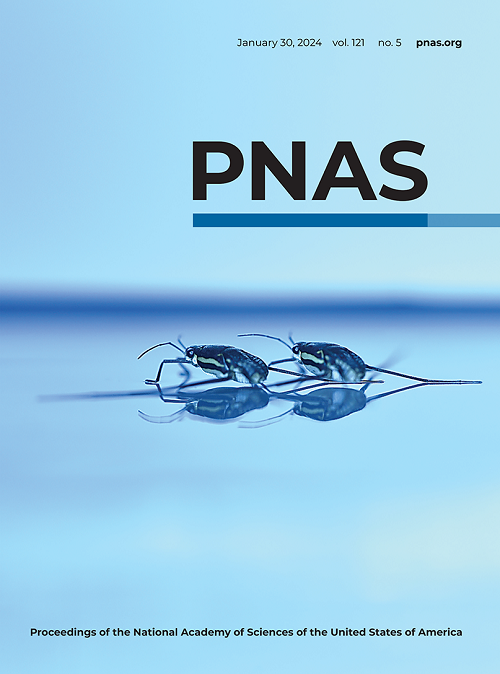Molecular determinants of sialylated IgG anti-inflammatory activity
IF 9.4
1区 综合性期刊
Q1 MULTIDISCIPLINARY SCIENCES
Proceedings of the National Academy of Sciences of the United States of America
Pub Date : 2025-05-16
DOI:10.1073/pnas.2411600122
引用次数: 0
Abstract
IgG antibodies are the basis for many successful therapeutics. A single, N-linked glycan is present on the Fc on all IgGs, and the composition of that glycan exerts marked influence over effector functions of the IgG. We and others have shown terminal sialylation of the Fc glycan confers anti-inflammatory activity to the IgG1 subclass and is thought to be responsible for the anti-inflammatory activity of high-dose intravenous immunoglobulin. However, whether sialylation results in anti-inflammatory activity for other IgG subclasses is unknown. We found that IgG1 and IgG3, but not IgG2 nor IgG4, suppressed autoantibody-mediated inflammation in vivo when sialylated. This activity was dependent upon human DC-SIGN or its murine ortholog, SIGN-R1. Fc γ receptor-binding profiles for asialylated and sialylated IgG subclasses reinforced these similarities, with IgG1 and IgG3 sharing binding patterns. Amino acid sequence alignments identified two uniquely conserved amino acid residues at positions 234 and 327 of the CH2 domain of all human IgG1 and IgG3 allotypes that were distinct from IgG2 and IgG4. Indeed, molecular modeling of the shared residues in IgG1 and IgG3 revealed a hydrophobic-heavy interchain interaction that was not present in IgG2 nor IgG4. Introduction of those IgG1/3 residues into an IgG4-Fc resulted in anti-inflammatory activity in vivo when sialylated. Conversely, a reciprocal sialylated IgG1 mutant with IgG2/4 residues lacked anti-inflammatory activity. These results define the amino acid requirements of anti-inflammatory sialylated IgG and enable rational amino acid and glycan engineering across all therapeutic IgG subclasses.唾液化IgG抗炎活性的分子决定因素
IgG抗体是许多成功疗法的基础。在所有IgG的Fc上都存在一个单一的n链聚糖,并且该聚糖的组成对IgG的效应功能有显著的影响。我们和其他人已经证明Fc聚糖的末端唾液酰化赋予IgG1亚类抗炎活性,并且被认为是高剂量静脉注射免疫球蛋白抗炎活性的原因。然而,唾液化是否会导致其他IgG亚类的抗炎活性尚不清楚。我们发现IgG1和IgG3,而不是IgG2和IgG4,在唾液化后抑制体内自身抗体介导的炎症。这种活性依赖于人类DC-SIGN或其小鼠同源物SIGN-R1。唾液化和唾液化IgG亚类的Fc γ受体结合谱增强了这些相似性,IgG1和IgG3共享结合模式。氨基酸序列比对发现,所有人IgG1和IgG3的CH2结构域的234和327位有两个独特的保守氨基酸残基,与IgG2和IgG4不同。事实上,IgG1和IgG3中共享残基的分子模型揭示了在IgG2和IgG4中不存在的疏水重链相互作用。将这些IgG1/3残基引入IgG4-Fc后,唾液化后在体内产生抗炎活性。相反,具有IgG2/4残基的互唾液化IgG1突变体缺乏抗炎活性。这些结果确定了抗炎唾液化IgG的氨基酸需求,并使所有治疗性IgG亚类的氨基酸和聚糖工程成为可能。
本文章由计算机程序翻译,如有差异,请以英文原文为准。
求助全文
约1分钟内获得全文
求助全文
来源期刊
CiteScore
19.00
自引率
0.90%
发文量
3575
审稿时长
2.5 months
期刊介绍:
The Proceedings of the National Academy of Sciences (PNAS), a peer-reviewed journal of the National Academy of Sciences (NAS), serves as an authoritative source for high-impact, original research across the biological, physical, and social sciences. With a global scope, the journal welcomes submissions from researchers worldwide, making it an inclusive platform for advancing scientific knowledge.

 求助内容:
求助内容: 应助结果提醒方式:
应助结果提醒方式:


